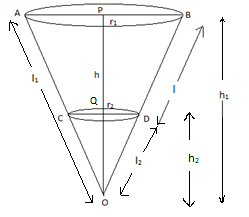Question
Question: Derive the formula for the volume of a cone, given to you in the figure using the symbols as explain...
Derive the formula for the volume of a cone, given to you in the figure using the symbols as explained.

h = height of frustum
l = slant height of frustum
r1 = radius PB
r2 = radius QD
Solution
Hint: We will assume the height of the cone, slant height of the cone OCD also its slant height to be a variable. Then we will write these variables into the given variables in the question. To calculate the volume of frustum, we will subtract the volume of the cone OCD from the volume of the cone AOB.
Complete step-by-step answer:
We have been given the height of the frustum (h), radius of upper part (r1), slant height (l) and radius of lower part of frustum (r2) as shown in the figure.

Now let us assume OP=h1,OQ=h2,OD=l2,OA=l1.
From the above figure, we can observe that OA = OC + AC.
We can see that OC = OD = l2 and AC = BD = l. So we can substitute it as,
⇒l1=l2+l.....(1)
Also, OP = OQ + PQ
⇒h1=h2+h.....(2)
As we know that the volume of frustum is equal to the difference between the cone OAB and cone OCD.
⇒Volume of frustum = volume of cone OAB – volume of cone OCD
We know that if a cone has radius and height r and h respectively, then its volume is as follows:
⇒Volume of cone =31πr2h
⇒Volume of cone OAB =31πr12h1
Now in ΔOPB and ΔOQD,
∠BOP=∠DOQ
As both angles are common to the triangles
∠OPB=∠OQD
Since both angles are 90∘ as height are perpendicular
⇒ΔOPB∼ΔOQD by AA angle similarity
As we know that the corresponding sides of a similar triangle are proportional,
